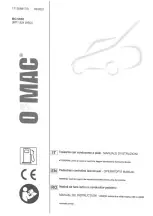
GB-NL-F-28
GB
OPERATION OF THE
MACHINE
Read the Safety Instructions.
Before starting the engine it will be necessary to fill
the fuel tank (A Fig.17) with Diesel fuel, fill the engine
sump through the filler (A Fig.18) with oil and fill the
radiator (A Fig.19) and expansion bottle (B Fig.19)
with a 50% anti-freeze solution.
Proceed as follows:-
1. Fuel System
Fill fuel tank (A Fig.17) with Diesel fuel No. 2-D
(ASTM D975) .
All Diesel-engined machines are despatched with the
fuel system already vented and are left
with a
small amount of fuel in the tank with the tap in the
'ON' position. If the engine has been allowed to run
dry, or the tap has been turned off, then the fuel
system must be vented. Proceed as follows:
(a)
Fill the fuel tank to the fullest extent. Open the
fuel filter tap (B Fig.17).
(b)
Open the air vent tap on top of the fuel injector
pump (A Fig.20).
(c)
Crank the engine for about ten seconds, , or
operate the fuel feed pump lever by hand
(optional).
(d)
Close the air vent tap on top of the injector
pump (A Fig.20).
NOTE: Always keep the air vent tap on the fuel
injector pump closed except when air is being
vented, or it may cause the engine to stop.
(e)
Repeat 'b', 'c' & 'd' above as necessary until
engine fires.
2. Engine Lubrication Oil
(a)
Fill the engine sump with oil to API
classification CC/CD/CE grade through the filler
(A Fig.18)
(b)
Always check level of oil with the dipstick
(B Fig.21) and ensure machine is on level
ground when checking. Capacity 9.5 litres
(16.72 Imp pints) (20.08 US pints)
3. Coolant
Fill the radiator (A Fig.19) and half fill the expansion
tank (B Fig.19) with a 50% anti-freeze solution.
Capacity6.8 litres (12 imp pints) (14.4 US pints)
IMPORTANT NOTES -
Always allow the engine to warm up sufficiently
before full load and speed is applied, otherwise
the life of the engine will be shortened.
Fig.17
Fig.18
Fig.19
Fig.20
Summary of Contents for Commander 3510
Page 2: ...2000 Textron Inc All Rights Reserved...
Page 4: ...GB NL F 2 Fig 1...
Page 38: ...GB NL F 36 GB...
Page 68: ...GB NL F 66 Fig 49...
Page 70: ...GB NL F 68 Fig 50 1 2 3 4 5 6 7 8 9 10 11 12 13 14 15 16 17 18 19 20 21 22 23 24 25 26 27 28...
Page 72: ...GB NL F 70 Fig 50 1 2 3 4 5 6 7 8 9 10 11 12 13 14 15 16 17 18 19 20 21 22 23 24 25 26 27 28...
Page 74: ...GB NL F 72 Fig 50 1 2 3 4 5 6 7 8 9 10 11 12 13 14 15 16 17 18 19 20 21 22 23 24 25 26 27 28...
Page 76: ...GB NL F 74 Fig 51 6 2 3 4 5 1 7 8 9 10 11 12 13 14 15 16 17 18 19 20 22 21 23 24...
Page 78: ...GB NL F 76 Fig 51 6 2 3 4 5 1 7 8 9 10 11 12 13 14 15 16 17 18 19 20 22 21 23 24...
Page 80: ...GB NL F 78 Fig 51 6 2 3 4 5 1 7 8 9 10 11 12 13 14 15 16 17 18 19 20 22 21 23 24...
Page 82: ...GB NL F 80 Fig 52...
Page 84: ...GB NL F 82 Fig 52...
Page 86: ...GB NL F 84 Fig 52...
Page 88: ...GB NL F 86 Fig 53...
Page 90: ...GB NL F 88...
Page 92: ...GB NL F 90...
Page 98: ...D I 2 Fig 1...
Page 132: ...D I 36 D...
Page 160: ...D I 64 Fig 49...
Page 162: ...D I 66 Fig 50 1 2 3 4 5 6 7 8 9 10 11 12 13 14 15 16 17 18 19 20 21 22 23 24 25 26 27 28...
Page 164: ...D I 68 Fig 50 1 2 3 4 5 6 7 8 9 10 11 12 13 14 15 16 17 18 19 20 21 22 23 24 25 26 27 28...
Page 166: ...D I 70 Fig 51 6 2 3 4 5 1 7 8 9 10 11 12 13 14 15 16 17 18 19 20 22 21 23 24...
Page 168: ...D I 72 Fig 51 6 2 3 4 5 1 7 8 9 10 11 12 13 14 15 16 17 18 19 20 22 21 23 24...
Page 170: ...D I 74 Fig 52...
Page 172: ...D I 76 Fig 52...
Page 174: ...D I 78 Fig 53...
Page 176: ...D I 80...
Page 178: ...D I 82...
Page 182: ...D I 86...
Page 183: ......
















































